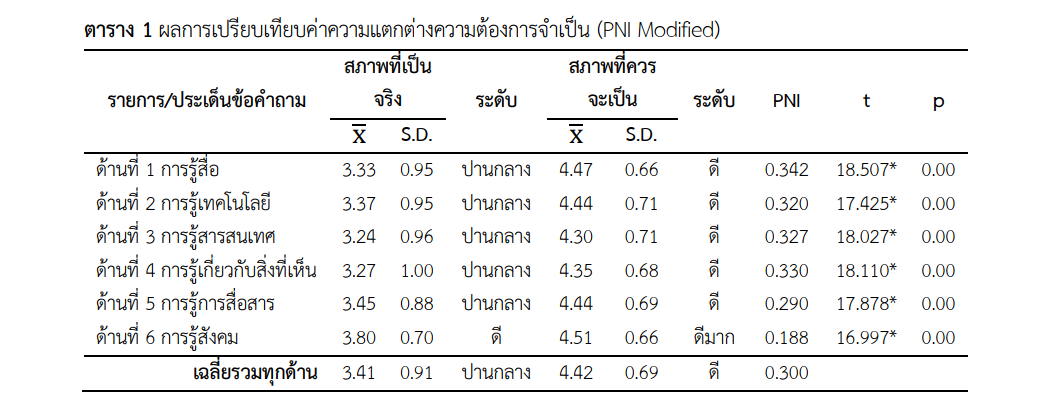Development of Training Curriculum to Enhance Innovation and Technology Ability in Physical Education Learning Management for Physical Education Students
DOI:
https://doi.org/10.14456/psruhss.2024.28Keywords:
Training curriculum development, Innovation and technology ability in physical education learning management, Physical education studentAbstract
The objective of this research and development was to develop a training curriculum to enhance innovation and technology ability in physical education learning management for physical education students. The research was divided into 3 phases. Phase 1) studying the needs in enhancing innovation and technology ability in physical education learning management. Data were collected from 432 physical education students in the 1st – 4th year of 13 universities in the northern region by stratified random sampling. Phase 2) Creating and developing a training curriculum to enhance innovation and technology ability in physical education learning management as well as organizing seminars based on 8 experts were used to assess the quality of the curriculum and its supporting documents before applying the course to the actual training. Phase 3) Experimenting and studying the results of using the training course and competency assessment to enhance innovation and technology ability in physical education learning management in terms of knowledge, characteristics, practical skills and assessing satisfaction with the training course. The sample consisted of 30 students from the department of Physical Education, Uttaradit Rajabhat University, acquired by purposive sampling. The results showed that:
1. The enhancing innovation and technology ability in physical education learning management is needed at a high level. (PNI Modified equated to 0.300).
2. The result of creation and development of the training curriculum revealed that there were 6 curriculum components including. (1) Principles of the curriculum, (2) Objectives, (3) Content, (4) Training activities and methods, (5) Curriculum materials, and (6) Curriculum evaluation. Additionally, there were two parts of the curriculum documents, namely (1) Manual for using the training curriculum and (2) plan of training activity. The quality assessment by experts, it was found that training curriculum and curriculum documents correctness and appropriateness, and usefulness and possibilities were at the highest level, ( = 4.61, S.D. = 0.42) and (
= 4.55, S.D. = 0.45) respectively.
3. Physical education students had scores for innovation and technology competency in physical education learning management in each aspect as follows:
3.1 Knowledge after the training was higher than before the training with statistically significant at the .05.
3.2 Characteristics was at good level.
3.3 Practical skills was at good level.
3.4 The physical education students were satisfied with the training curriculum at the highest level.
References
กระทรวงศึกษาธิการ, สำนักงานเลขาธิการสภาการศึกษา. (2560). แผนการศึกษาแห่งชาติ พ.ศ. 2560-2579 (พิมพ์ครั้งที่ 2). กรุงเทพฯ: สำนักงานเลขาธิการสภาการศึกษา.
กระทรวงศึกษาธิการ. (2551). หลักสูตรแกนกลางการศึกษาขั้นพื้นฐาน พุทธศักราช 2551. กรุงเทพฯ: โรงพิมพ์ชุมนุมสหกรณ์การเกษตรแห่งประเทศไทย.
ทิศนา แขมมณี. (2555). ศาสตร์การสอน: องค์ความรู้เพื่อการจัดกระบวนการเรียนรู้ที่มีประสิทธิภาพ (พิมพ์ครั้งที่ 6). กรุงเทพฯ: จุฬาลงกรณ์มหาวิทยาลัย.
ประกาศข้อบังคับคุรุสภาว่าด้วยมาตรฐานวิชาชีพ ฉบับที่ 4 พ.ศ. 2562, (7 พฤษภาคม 2563). ราชกิจจานุเบกษา. เล่มที่ 137 ตอนพิเศษ 109 ง. หน้า 10-14.
พงษ์เอก สุขใส. (2561). ครูพลศึกษาในศตวรรษที่ 21. วารสารวิชาการมหาวิทยาลัยฟาร์อีสเทอร์น, 12(ฉบับ Supplement), 8-21.
ภูฟ้า เสวกพันธ์. (2562). การศึกษาแบบเรียนร่วม: ปฏิบัติการขั้นสูงในศตวรรษที่ 21. กรุงเทพฯ: จุฬาลงกรณ์มหาวิทยาลัย.
รสสุคนธ์ มกรมณี. (2556). “ครูไทยกับ ICT”. ใน การประชุมทางวิชาการของคุรุสภาประจำปี 2556 เรื่อง การวิจัยเพื่อเพิ่มคุณภาพการศึกษาและพัฒนาวิชาชีพ. กรุงเทพฯ: สำนักงานเลขาธิการคุรุสภา.
วาสนา คุณาอภิสิทธิ์. (2561). หลักสูตรและการจัดการเรียนรู้พลศึกษา. กรุงเทพฯ: ศูนย์ส่งเสริมวิชาการ.
สำนักงานคณะกรรมการพัฒนาเศรษฐกิจและสังคมแห่งชาติ. (2562). ยุทธศาสตร์ชาติ 20 ปี พ.ศ. 2561-2580. กรุงเทพฯ: สำนักงานคณะกรรมการพัฒนาเศรษฐกิจและสังคมแห่งชาติ.
สำนักนายกรัฐมนตรี สำนักงานคณะกรรมการการศึกษาแห่งชาติ. (2545). พระราชบัญญัติการศึกษาแห่งชาติ พ.ศ.2542 แก้ไขเพิ่มเติม (ฉบับที่ 2) พ.ศ. 2545. กรุงเทพฯ: พริกหวาน กราฟฟิค.
สุนีย์ ภู่พันธ์. (2546). แนวคิดพื้นฐานการสร้างและการพัฒนาหลักสูตร. เชียงใหม่: The Knowledge Center.
อัสรี สะอีดี. (2561). การพัฒนาหลักสูตรฝึกอบรมเพื่อเสริมสร้างสมรรถนะของครูพลศึกษาในศตวรรษที่ 21 โดยประยุกต์ใช้การอำนวยความสะดวกในการเรียนรู้ร่วมกับการสอนแบบเสริมศักยภาพ (วิทยานิพนธ์ครุศาสตรดุษฎีบัณฑิต). กรุงเทพฯ: จุฬาลงกรณ์มหาวิทยาลัย.
อํานวย เดชชัยศรี, และณัฐกานต์ ภาคพรต. (2553). หนังสือเรียนรายวิชาพื้นฐานเทคโนโลยีสารสนเทศ ม.4. กรุงเทพฯ: วัฒนาพานิช.
Bloom, B. S. (1956). Taxonomy of Educational Objectives, the classification of educational goals – Handbook I: Cognitive Domain. New York: McKay.
Cronbach, L. J. (1970). Essentials of psychological testing. (3rded.). New York: Harper & Row.
Likert, R. (1967). The Method of Constructing and Attitude Scale. Attitude Theory and Measurement. Fishbeic, Martin, Ed. New York: Wiley & Son.
Prasith-Rathsint, S. & Sookasame K. (2004). Qualitative Research Methodology: Research on Current Issues and Futures Research. Bangkok: Fueang Fa Printing House.
Taba, H. (1962). Curriculum Development: Theory and Practice. New York: Harcourt, Brace & World.
Yamane, T. (1973). Statistics: An Introductory Analysis (3rd ed.). New York: Harper and Row.

Downloads
Published
How to Cite
Issue
Section
License
Copyright (c) 2024 Humanities and Social Sciences Journal of Pibulsongkram Rajabhat University

This work is licensed under a Creative Commons Attribution-NonCommercial-NoDerivatives 4.0 International License.
Any articles or comments appearing in the Journal of Humanities and Social Sciences, Rajabhat Phibulsongkram University, are the intellectual property of the authors, and do not necessarily reflect the views of the editorial board. Published articles are copyrighted by the Journal of Humanities and Social Sciences, Rajabhat Phibulsongkram University.








